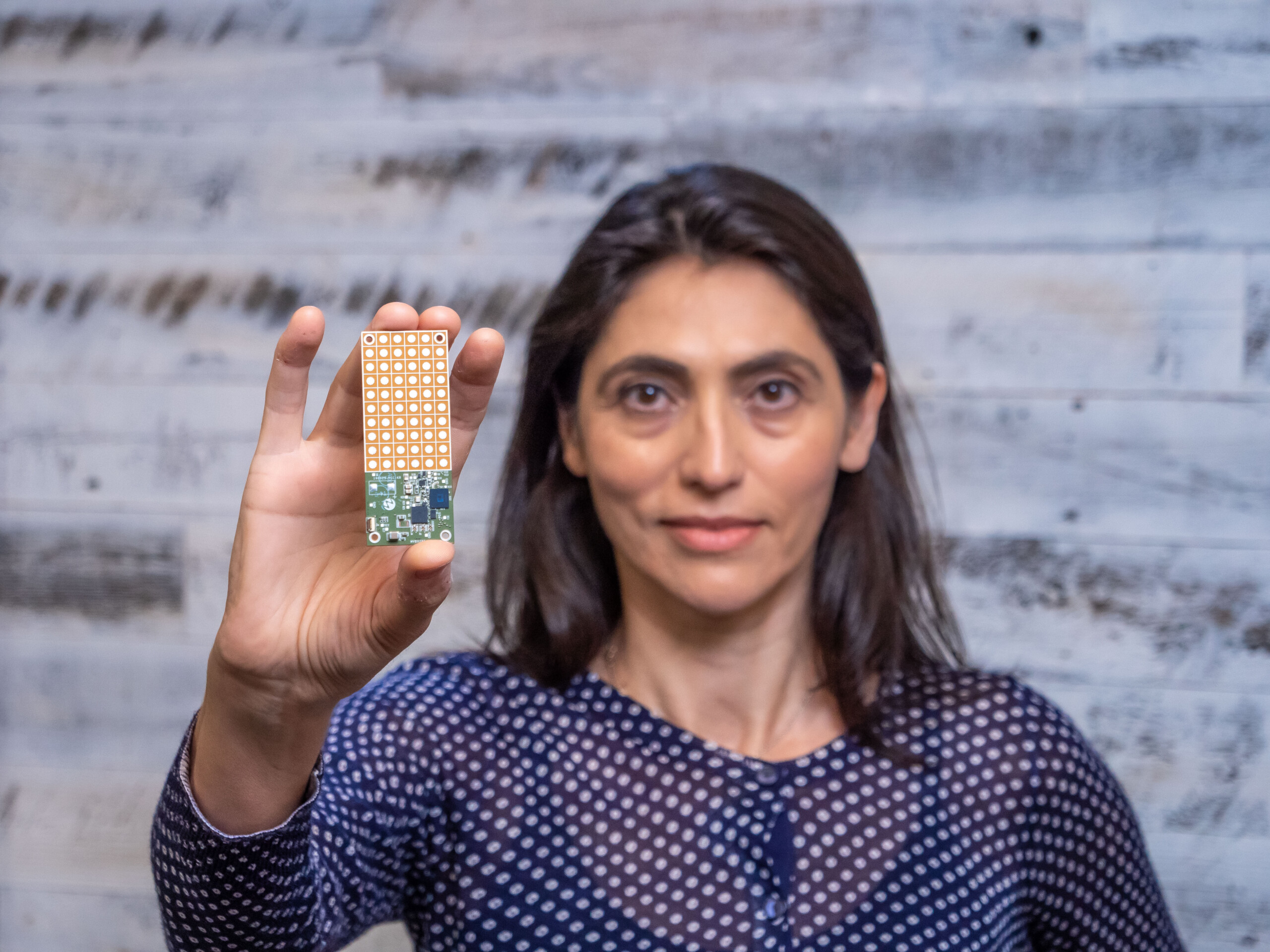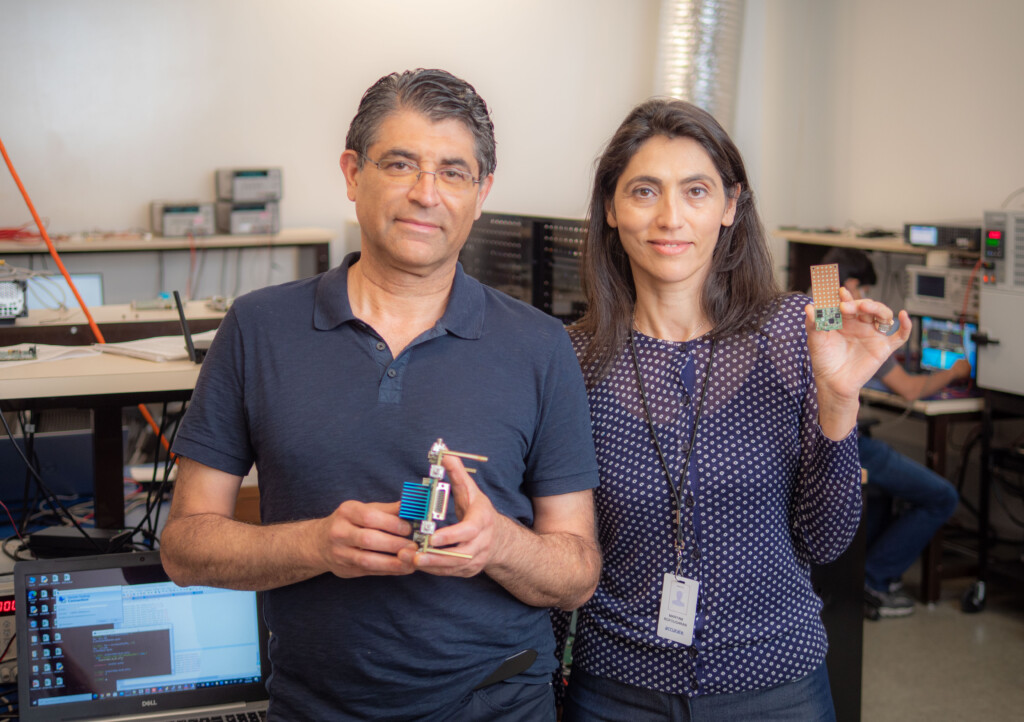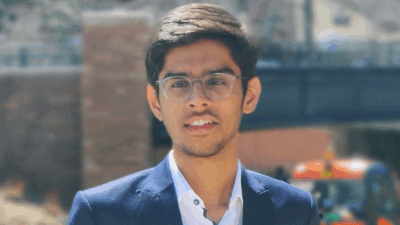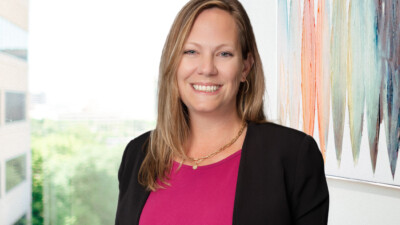Maryam Rofugaran co-founded Movandi with her brother. The two come from a long line of family engineers.

When you grow up surrounded by people in similar professions, you just might end up in the same line of work. It rubs off. That’s the case with Maryam Rofugaran, who co-founded Movandi with her brother Reza. Movandi designs and manufactures semiconductors for mmWave communications (24 GHz to 70 GHz); that includes beamformers, up/down converters, and synthesizers. The company also makes phased-array modules, and on the equipment side, 5G repeaters that bring mmWave signals into buildings.
Growing up surrounded by engineers, it’s no surprise that Maryam and Reza both followed their uncles into engineering. “In my family,” explained Maryam, “we have a lot of engineers. My uncles were engineers, though not all were electrical engineers. My mom’s uncle was a well-regarded physicist in my country. He wrote books that were used in universities.”
“We always had an interest in science and math,” she continued. “The four siblings in my family always gravitated or were pulled into math and physics. From early on, I enjoyed solving difficult math problems, even as a hobby and not just in school. I’d try to attack and solve them.” She also admitted to loving a documentary film about Einstein’s theories even though she didn’t understand them at the time.
After graduating from high school, Maryam followed Reza to Los Angeles. There, where he was studying electrical engineering at UCLA. Though before she could get there, she needed her acceptance from USC to get a student visa. She spent nine months in Germany before the paperwork was done.
Maryam’s first exposure to electrical engineering came when she visited Reza’s lab at UCLA. Seeing people using computers to design ICs and circuits convinced her to take some EE courses. Seeing what you can design was enough to convince her to study EE rather than physics or math.
Maryam spent two semesters at USC before transferring to UCLA, where she completed her bachelor’s and master’s degrees. She was halfway through a PhD program when she dropped out to start her first company with Reza, called Innovent Systems.
At UCLA, they were able to show that both 900 MHz RF and digital circuits could be integrated onto a CMOS IC. The prototype, which grew from that project, showed that such a combination on CMOS was possible, but not practical to manufacture at a low enough cost, given the technology at the time. Reza worked on the RF section, which began his and later Maryam’s interest in wireless communications.
At around that time, Bluetooth and WiFi began to appear. Working with Broadcom, the Rofugarans chose Bluetooth for their next project, but designed it for WiFi use as well. After all, both technologies operate at 2.4 GHz — today’s 5 GHz and 6 GHz WiFi didn’t exist then.
The technology attracted interest from Intel and Qualcomm. Both companies wanted to acquire Innovent Systems. Maryam and Reza chose Broadcom. At the time, Broadcom had just issued its initial public offering, so Maryam noted that it too was essentially a startup, though much larger than Innovent Systems. That was around the year 2000.
Maryam and Reza were instrumental in designing radios for Broadcom. “It started with Bluetooth,” said Maryam, then we added WiFi, GPS, and near-field communications (NFC), integrating them with digital circuits on the same chip. Broadcom shipped parts to companies such as Nokia and Samsung with 3G and later 4G radios. They added carrier aggregation and eventually designed radios operating at frequencies up to 60 GHz. That’s when they decided to follow their passions for mmWave and the coming of 5G.
The big move
Maryam and Reza left Broadcom in April 2016 to start Movandi, where they develop products based on mmWave technology.

On the surface, you may question such a move. The Rofugarans have, you might say, bet their life savings on mmWave, a technology that, on the surface, seems unlikely to go mainstream, at least from a smartphone perspective.
“It takes a lot of effort for people to actually understand what mmWave can do, what it cannot do, what best applications it can support. Millimeter wave signals cannot easily travel through metals and they have short ranges because of the short wavelength (1 cm at 30 GHz). It has blockage issues, but these are the challenges that need to be solved. Having done so many things that at one point people said were impossible, we believe that if you focus on the challenge, and you address the challenge, you can come up with the technology that could be a game changer.” That’s why in addition to designing mmWave semiconductors, Movandi also provides what it calls “smart repeaters” to bring mmWave signals indoors.
What you get from mmWave is large bandwidth that’s impossible to get at the sub-6 GHz frequencies where 5G mostly lives. Having worked with frequencies up to 60 GHz at Broadcom, Maryam and Reza knew the challenges, even though most 5G mmWave use is currently at or below 30 GHz.
Rather than focusing only on semiconductors, the Rofugarans also took a systems approach by designing smart repeaters to bring 5G mmWave signals indoors. They worked not just on chipsets because they can be made at low cost and deliver high performance, but that wasn’t good enough. “You don’t just build something in a completely new technology and then try to repeat the same deployment, right? We came up with our own algorithm to make repeaters that are smart, unlike analog repeaters. We have shown in many cases how these things can change an industry.”
You may recall the initial 5G hype where operators were touting blazing download speeds. According to Maryam, that gave the wrong impression of 5G. Now many telecom pundits say mmWave has failed. That, however, is based on a narrow vision where they only look at it from a smartphone perspective. Other applications, powered by Movandi products, can still make mmWave a game-changing technology. Think stadiums, private networks, and fixed-wireless internet access (FWA).
Maryam sees FWA as the technology that will bring mmWave to the masses. Why? Because the 5G midband, roughly 3 GHz to 7 GHz, will run out of capacity. Making incremental changes to radio modulation, for example, will only go so far.
Maryam also noted a common issue with new technologies, the “chicken and the egg” issue. In the case of mmWave, more deployment or more devices that support it will drive the technology forward. She noted that Movandni has repeaters installed in Tokyo but, she said, Apple phones in Japan don’t support mmWave. “It’s taken longer than I would have hoped, she said, but it will come.”
The game changer will be AI and the amount of data it will need and will create.
AI and engineers
While AI could push mmWave over the top, AI will also change how engineers work. Indeed, Maryam noted that using AI gives her more time for engineering work by getting her through emails faster, but it’s also an engineering tool. She explained that AI won’t replace engineers, but it could make engineers more efficient. “With AI, you won’t need lower-level engineers just sitting at a computer doing simulation. AI can produce a design much faster than people, but at the same time will also require people with a higher skill level. I think a combination of AI with smart people is where we’re going, and I think the efficiency will become much higher.”
She does, however, worry about the potential negatives of AI. She explained the possible effect on children’s abilities to solve problems, “It could have a negative effect on their creativity and their learning. I’m hoping that we can advance AI as much as we should because it definitely helps us. At the same time, we need to manage it in a moral, dignified manner so that our society benefits from it.”




